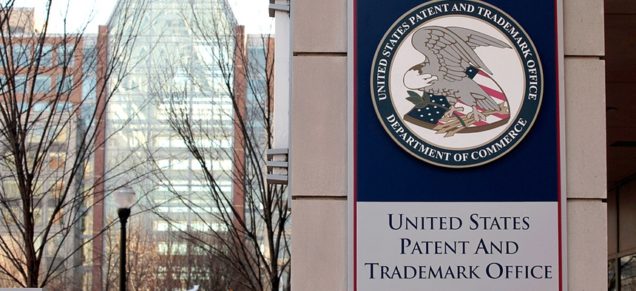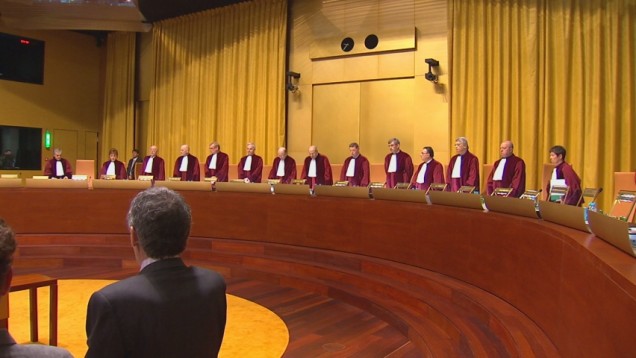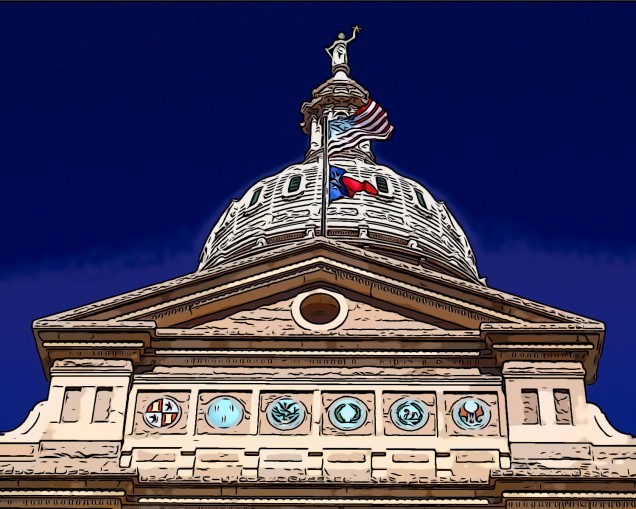Category: Legislation in Court
Kentucky Medical Review Panels: A Toe in the Water of Tort Reform
In March, the 2017 Kentucky General Assembly passed SB4: AN ACT relating to medical review panels. Sponsored by Senator Ralph Alvarado, a physician from Winchester, the bill establishes medical review panels as a first stop for any medical malpractice claim in Kentucky. The new statute provides that, prior to filing a lawsuit for medical malpractice against a health care provider or institution, all claims shall be reviewed by a medical review panel. This post will explore the new law and describe the difficulty of predicting the exact effect that the medical review panel will have on malpractice suits in Kentucky.
To file a medical malpractice suit in a Kentucky court, a complainant must present their potential claim to the panel and have received an opinion regarding their claim. The panel, made up of three healthcare providers and a non-voting attorney chairman, has up to nine months to give its opinion of the malpractice-related claim. The panel can decide that a plaintiff’s case has no merit, that there was a failure by the defendant to provide proper care, or that there was a failure to provide proper care, but the misconduct did not lead to a negative medical result. Regardless of the opinion issued by the panel, the plaintiff may still take their case to court. The opinion issued by the panel is admissible at trial and the doctors on the panel may be called as witnesses.
Why put these hurdles to litigation in place? Critics have long argued that too many meritless medical malpractice claims are filed each year, which causes health care provider liability insurance to skyrocket and encourages the practice of “defensive” medicine. Concerns that too many malpractice claims are “frivolous and request unrealistic damages” date back to the mid-1970’s. Another concern which prompted this change in the law, according to Rep. Robert Benvenuti of Lexington, is that the current medical malpractice process is slow and “drags on for years and years and years [and] it ends by the judge encouraging or sometimes ordering mediation.” According to Benvenuti, the panels speed up the process by putting mediation on the front end.
Kentucky is only the latest in a number of states which have implemented these medical review panels. Medical review panels have been the proposed and implemented solution for the highly litigious area of medical malpractice, but it begs the question, do they actually work? The data varies by state, and the extent of tort reform implemented in different states can make it difficult to determine the effect of just implementing medical review panels. For example, data from the National Association of Insurance Commissioners found that malpractice premiums in California grew much more slowly than the rest of the nation after it passed comprehensive tort reform. Unlike Kentucky, California’s tort reform included caps on non-economic damages, changing payout requirements, limitations on attorney fees, and a required 90-day notice to file a lawsuit, but does not require medical review panels.
 Studies on the isolated effect of just medical review panels are sparse. The most comprehensive study on the effect of medical review panels dates all the way back to 1986, finding that the panels caused an overall increase in the number of disputes, overall costs, and lengthening of time of the process. However, a more recent study commissioned by the American Medical Association (an advocate of tort reform) in 2008 found that states with screening panels generally medical liability insurance rates 20% below the national average and had a higher percentage of cases that settled more quickly or closed without a payout. Maine, whose panel law has been in place for more than 30 years, had 20-30% lower insurance rates than neighboring New Hampshire prior to New Hampshire’s passing of its own panel law. Between 1996 and 2006, the Senior Vice President of Medical Mutual Insurance in Maine stated in 2009 that average expenses for medical malpractice claims in Maine were 66% lower than in New Hampshire, and only 2.5% of claims went to trial, as compared to 7% in New Hampshire.
Studies on the isolated effect of just medical review panels are sparse. The most comprehensive study on the effect of medical review panels dates all the way back to 1986, finding that the panels caused an overall increase in the number of disputes, overall costs, and lengthening of time of the process. However, a more recent study commissioned by the American Medical Association (an advocate of tort reform) in 2008 found that states with screening panels generally medical liability insurance rates 20% below the national average and had a higher percentage of cases that settled more quickly or closed without a payout. Maine, whose panel law has been in place for more than 30 years, had 20-30% lower insurance rates than neighboring New Hampshire prior to New Hampshire’s passing of its own panel law. Between 1996 and 2006, the Senior Vice President of Medical Mutual Insurance in Maine stated in 2009 that average expenses for medical malpractice claims in Maine were 66% lower than in New Hampshire, and only 2.5% of claims went to trial, as compared to 7% in New Hampshire.
Other states, like Nevada, have found mixed success, causing thirty states to repeal panel laws and often replace them with other methods of tort reform. Nevada found out the hard way that if doctors on the panel and insurance companies fail to play by the rules, the functionality of medical panels becomes moot. Sen. Alvarado has stated himself that the doctors of Kentucky must be ready to serve on the panels if called upon. Additionally, the Kentucky Medical Association Director of Advocacy and Legal Affairs stated that the panels will “succeed or fail based largely on the participation of physicians,” and that success of the panels will guide future tort reform in Kentucky.
Another claim by the proponents of the new law are that medical review panels will bring speedier resolutions to malpractice claims. How speedy of a process this will prove to be remains to be seen. The panels have up to nine months to make a decision, and any other claims dependent on the medical malpractice claim are stayed from the time the complaint is filed with the panel until the decision is made. However, potential plaintiffs who receive negative opinions from the panel may be discouraged from pursuing their claim in court or choose to settle more quickly.
Regarding Rep. Benvenuti’s comparison of the panel process to mediation, this association is flawed, since the opinions are admissible and the panel members may be called as witnesses at trial. Where required mediation would encourage an honest look at the merits and encourage settlement of these medical malpractice claims out of court, which the proponents of this legislation claimed as one of their goals, this panel process could very well just turn into an out of court trial that proves to be just as costly for claimants. Some claimants with legitimate claims of medical malpractice may be deterred from pursuing their medical malpractice claims entirely, because the total cost and length of litigation could well be extended by lengthy statements and extensive discovery. Also unclear is how the panel system will affect billing for claimants. Often, medical malpractice plaintiffs are billed on contingency. Changing the system may make pursuit of these claims more cost prohibitive for potential plaintiffs.
Not only seen as potentially cost-prohibitive and discouraging to litigation, some view the medical review panels as a bar to litigation because it restricts the right of people to plead their cases in court. The Franklin Circuit Court struck down Kentucky’s new law in October 2017, and the case will be heard by the Kentucky Supreme Court in its upcoming session in 2018.
While the full effects of Kentucky’s new medical review panels remain to be seen, the likely next step for the Kentucky legislature will not be a surprise. If the panels are successful and accurately weed out frivolous malpractice claims, then the average payout for medical malpractice suits will likely increase. Claimants with favorable opinions from the panel will likely continue to pursue their claim and can use the panel opinion to their advantage in court to get higher payouts. The second main concern with medical malpractice litigation is that plaintiff request unrealistic damages. Likely the Kentucky General Assembly will want to temper increased payouts for medical malpractice suits. The American Medical Association considers Kentucky as a state in a medical malpractice crisis because it has no laws capping non-economic damages in medical malpractice suits. Senator Alvarado, who filed the bill creating these medical review panels, has already expressed his desire to institute a constitutional amendment which would cap damages for pain and suffering in medical malpractice claims. With a Republican super-majority in Frankfort, it seems as though Kentucky is on the verge of diving in to full tort reform.
 Joye Beth Spinks anticipates graduating from Boston University School of Law in May 2019.
Joye Beth Spinks anticipates graduating from Boston University School of Law in May 2019.
Inter Partes Review: non-Article III Adjudication of Private Property Rights
In November 2017, the Supreme Court heard oral arguments for Oil States Energy Services, LLC v. Greene’s Energy Group. Oil States poses a question that forces the Supreme Court to consider whether it will turn patent strategy on its head: whether inter partes reviews (IPRs) violate the Constitution by extinguishing private property rights through a non-Article III forum without a jury. The Federal Circuit is notoriously the appellate circuit most reversed by the Supreme Court – by May 2017, the Court had reversed 25 of the 30 cases it accepted from the Federal Circuit. Will Oil States suffer the same fate?
An IPR, established as one of the cornerstones of the American Invents Acts (AIA) in 2011 and initiated in 2012, is a proceeding instituted by the U.S. Patent and Trademark Office (USPTO), upon petition by an outside party, allowing parties to challenge the validity of an issued patent before the Patent Trial and Appeals Board (PTAB), a non-Article III tribunal. Congress created IPRs primarily to increase the efficiency of an otherwise expensive and time consuming traditional patent validity challenge in court. While traditional patent litigation may consume millions of dollars and years of the parties’ time – a waste of financial and judicial resources and creating uncertainty within the field of technology encompassed by the patent – an IPR typically costs the parties a comparatively small six figure sum and the AIA requires the PTAB to issue a final written decision within one year of IPR institution.
Since 2012, IPRs have become a popular mechanism for parties to challenge the validity of patents – in part due to their efficiency and in part because the PTAB does not begin with a presumption of validity, whereas courts do. In effect, the PTAB has invalidated all claims of the challenged patent in over 1,200 proceedings, roughly 74% of all IPRs. Only 13% of IPRs result in no claims of a patent being invalidated.
The courts have already disposed of numerous challenges to the constitutionality of patent validity review procedures conducted before the USPTO. Before the AIA introduced IPRs, the USPTO had already been invalidating patents since 1981 via ex-parte reexamination. The Federal Circuit has repeatedly affirmed the constitutionality of the USPTO’s authority in such proceedings, stating that “[a] defectively examined and therefore erroneously granted patent must yield to the reasonable Congressional purpose of facilitating the correction of governmental mistakes.” Patlex Corp. v. Mossinghoff, 758 F.2d 594, 604 (Fed. Cir. 1985). The Federal Circuit has more recently denied a similar constitutional challenge to IPRs, stating that patent rights are public rights, reviewable by an administrative agency, and therefore assigning review of patent validity to the USPTO is consistent with Article III. MCM Portfolio LLC v. Hewlett-Packard Co., 812 F.3d 1284, 1291 (Fed. Cir. 2015).
Oil States challenged IPRs alleging a violation of both Article III and the Seventh Amendment. Concerning Article III, Oil States argued that it is unconstitutional for a non-Article III court / Article I tribunal to adjudicate private property. Oil States argued that the Seventh Amendment guarantees patent owners the right to a jury trial because historically, patent infringement cases have been heard in courts of law in England before juries.
Oil States argued that the Supreme Court has once before reviewed and disavowed USPTO patent validity review procedures (otherwise, the Court has only denied certiorari in the past to review Federal Circuit decisions treating the question, including the two above decisions) and the differences in the statutorily created IPR and ex parte reexamination.
In 1898, the Supreme Court held that “the Patent Office has no power to revoke, cancel, or annul” an issued patent. McCormick Harvesting Mach. Co. v. Aultman & Co., 169 U.S. 606 (1898). However, this case did not concern the constitutionality of such proceedings, and it is likely that the Court will limit McCormick to the narrow position that the USPTO does not exercise jurisdiction over an issued patent in the absence of authorization from Congress, as was lacking in 1898. Now that Congress has expressly authorized such review via the AIA, the Court will likely find such review constitutional.
Oil States highlights the differences between AIA-created IPRs and ex parte reexaminations; IPRs are adversarial proceedings including discovery, briefings, hearings, and a final judgment, whereas ex parte reexaminations are more akin to interactive proceedings between the agency and patent owner.
To resolve this case, the Court will likely stay away from disclaiming the statutory distinctions establishing IPRs as trial-like proceedings, because these hold some legitimacy, and focus on whether a patent is a public or private right. If a patent is a public right, then there is no issue with IPRs being trial-like proceedings conducted before non-Article III adjudicators because it is proper for an agency to adjudicate a public regulatory scheme. If, on the other hand, patents are private rights, as Oil States contends, then the Court would be forced to either disavow IPRs or distinguish their characteristics from a trial. The Federal Circuit provided the Court with a mirror distinguishing IPRs from traditional trials, but this distinction is fragile at best. Ultratec, Inc. v. Captioncall, LLC, 2017 WL 3687453, *1 n.2 (Fed. Cir. Aug. 28, 2017). The Court would find more stable grounding classifying patents as quintessential public rights, conferred only by virtue of a statute.
The most curious note regarding the Supreme Court’s decision to hear Oil States is that it concurrently agreed to hear SAS Institute v. Lee, which asks the Court to consider whether the AIA permits the USPTO to select claims from a petition and partially institute an IPR or whether the USPTO must wholly grant or deny a petition, either blessing or damning all claims. If the Court intends to destabilize the AIA and declare IPRs unconstitutional, why consider the USPTO’s duty to the petitioner for an IPR in the same term? It is likely that the Supreme Court will uphold the constitutionality of the AIA’s grant of authority to the USPTO and permit IPRs to continue, but will use these two cases as an opportunity to either limit the scope and effect of IPRs or force clarity regarding the deficiencies of IPRs – such as lacking judicial rules of ethical conduct, improper handling of evidence, improper handling of amendments, or simply disregarding established standards in favor of PTAB-created standards.
Eric Dunbar anticipates graduating Boston University School of Law in May 2018.
The Role of the Courtroom in Combating Domestic Violence
The rhetoric surrounding the courtroom can be idealistic. The courtroom is supposed to be a symbol of justice, where every party has a fair opportunity to be heard. Yet the reality for survivors of domestic violence is far from this ideal. Survivors who have the strength to seek their day in court have already shown an incredible amount of strength and courage. They should be met with hope, encouragement, and assistance. But this is a goal yet to be achieved.
Survivors often feel unsafe walking into the courtroom. Not only are survivors at more risk after leaving their abuser, “[a]busers also use court appearances as opportunities to stalk and maintain contact with their ex-partners.” Survivors face an uphill battle in the courtroom. As Sara Ainsworth of Legal Voice stated, “[t]here's an enormous bias against anyone making accusations [of abuse].”
Domestic violence survivors may end up in the courtroom for a variety of reasons, including seeking a protective order and child custody proceedings. Current law in Massachusetts governing domestic violence in custody proceedings falls far short of the protection society owes to survivors. First, the definition of abuse is narrow, only encompassing physical abuse. Specifically, Massachusetts General Laws Section 31A defines abuse as “(a) attempting to cause or causing bodily injury; or (b) placing another in reasonable fear of imminent bodily injury.” The statute further states that either a pattern of abuse or a ‘serious incident’ of abuse (defined as “(a) attempting to cause or causing serious bodily injury; (b) placing another in reasonable fear of imminent serious bodily injury; or (c) causing another to engage involuntarily in sexual relations by force, threat or duress”), triggers a rebuttable presumption that granting the abuser sole or shared custody is not in the best interest of the child. The presumption is triggered by a preponderance of the evidence, and can be rebutted by a preponderance of the evidence. A past or current protective order does not automatically trigger the presumption.
Further, while the facts that brought about a protective order can be admissible, protective orders themselves cannot be admitted as evidence of abuse. This means that even if a survivor has succeeded in protecting herself and her child(ren) by obtaining a protective order, she will not automatically get custody of her children. She will have to face her abuser again in the courtroom, and will have to prove once again that abuse has occurred. Further, even if there was extensive verbal, emotional, and psychological abuse, the presumption against custody will not be triggered.
In addition to dealing with statutes that do not adequately protect them, survivors must also deal with judges who may not understand their experiences. In fact, women who are seeking protection for themselves and their children from an abuser are often met by similar behavior from judges. Domestic abuse is often described with what is termed the ‘Power and Control Wheel.’ The wheel describes that variety of ways abusers use their power to manipulate and control their victims. The Texas Council on Family Violence created a power and control wheel that describes the ways judges also reinforce women’s entrapment.
The role of the court in protecting domestic survivors must extend beyond equitable orders. It is an unfortunate truth that sexism is still a very real reality in the courtroom. Moreover, many judges do not understand the dynamics of domestic violence, and do not handle custody disputes with the appropriate sensitivity to domestic abuse, even if they are statutorily required to do so. Judges have the opportunity to empower victims, or to make them feel even less in control.
The idea that judges can play a positive role in protecting domestic abuse survivors is not new. In 1999, The Northeastern University Press published an article titled “Battered Women in the Courtroom: The Power of Judicial Responses.” The article lists multiple ways judges can support survivors: supportive judicial demeanor; take the violence seriously; make the court hospitable; prioritize women’s safety; address the economic aspects of battering; focus on the needs of children; enforce orders and impose sanctions on violent men; and connect women with resources. Specific recommendations targeted sexism during proceedings, including “refusing to joke and bond with violent men”; “talking with battered women rather than around them”; “correcting institutional bias in favor of men”; and “eschewing bureaucratic/perfunctory or hostile attitudes toward victims and casual or collusive attitudes with batterers.”
The article identified five types of judicial demeanor in hearings for protective orders: 1) good-natured; 2) bureaucratic; 3) firm or formal; 4) condescending; and 5) harsh. Interestingly, “[t]here types . . . were demonstrated toward violent men[:] [f]irm or formal, bureaucratic and good-natured. Most judges were good-natured with women and firm with violent men. Condescending and harsh demeanor was not directed toward violent men.” (emphasis added). There is no excuse for the gender discrimination revealed by this study.
While this study is dated, women still face judges who are hostile toward domestic violence survivors. Judges can make a difference by understanding that survivors can be overwhelmed in the courtroom; ensuring a the record is comprehensive; not blaming the victim; and having zero tolerance for violence and gender discrimination during proceedings.
Judges can be powerful role models by choosing to treat women with respect and taking the humble approach of recognizing their need to learn the dynamics of domestic abuse in order to be effective judges.
Boston University School of Law, class of 2018
Loopholes in the System: How Student Loan Litigation May Change Going Forward
In June 2014, the Department of Education greatly reduced its funding from the for-profit institution Corinthian Colleges, which had received $1.4 billion in funding annually from the federal government. But serious concerns that Corinthian had mishandled the funds, redirecting them to creditors and other avenues rather than to students, led to multiple federal and state investigations. Finally, the DOE took action – it stopped giving the institution federal loans. In April 2015, cut off from these loans, Corinthian shut down the last of its campuses’ doors. Now, many Corinthian students are looking for help with the student loans they have been saddled with, and with nothing to show for it. The DOE, in June 2015, released on its website the two ways in which it plans to help students with loans related to their education at Corinthian. For students who were attending the closed down campuses, there is the option of loan forgiveness. The DOE is expanding the class of students eligible for loan forgiveness to include those who attended the school as far back as June 2014.
More strikingly, the DOE is making an unprecedented move in extending a loan forgiveness option for  students under the “defense to repayment”. Defense to repayment claims are usually brought under state UDAP laws – Unfair and Deceptive Acts and Practices laws. These state level claims provide easier relief as they do not require proof of intent and reliance may be presume. However, this rule has yet to be enforced on a federal level – whether in the Corinthian case or any other direct loan dispute. In the past 15 years, the Department received a grand total of five claims under the ‘defense to repayment’ provision of the law. This is partly because, when the rule was promulgated there was no guidance on the procedures for filing, disputing and resolving a claim under defense to repayment. In December 2014, 12 U.S. senators, led by Elizabeth Warren submitted a letter to the Department of Education asking for clarification on defense to repayment. In response, the DOE is attempting to make the process easier for thousands of Corinthian borrowers by putting in place an application procedure.
students under the “defense to repayment”. Defense to repayment claims are usually brought under state UDAP laws – Unfair and Deceptive Acts and Practices laws. These state level claims provide easier relief as they do not require proof of intent and reliance may be presume. However, this rule has yet to be enforced on a federal level – whether in the Corinthian case or any other direct loan dispute. In the past 15 years, the Department received a grand total of five claims under the ‘defense to repayment’ provision of the law. This is partly because, when the rule was promulgated there was no guidance on the procedures for filing, disputing and resolving a claim under defense to repayment. In December 2014, 12 U.S. senators, led by Elizabeth Warren submitted a letter to the Department of Education asking for clarification on defense to repayment. In response, the DOE is attempting to make the process easier for thousands of Corinthian borrowers by putting in place an application procedure.
In another unprecedented move, the Consumer Financial Protection Bureau worked with a buyer of partial Corinthian campuses and the DOE to secure a settlement valued at $480 million in debt relief for private student loan borrowers who attended Corinthian at the time of closing. Students who have private loans are also reassured that strong arm tactics – such as harassing calls and lawsuits – will not be used against them to collect on loans. These students will also have negative credit history erased from their credit reports. A broader lawsuit is currently still pending against Corinthian alleging predatory techniques were used to induce students to take out private loans.
There may be sufficient reason to invoke the “defense against repayment” option in the case of Corinthian colleges. But this may open the floodgates to other claims, especially in the for-profit education industry, that could fall under the defense. As the issue of burgeoning student loans in the millennial generation becomes a larger issue for the economy, this tiny loophole could create huge impacts in the coming years. More and more disgruntled students taking action may mean this “defense to repayment” could be extended to private, non-federal loans and public universities.
Recently, Obama’s administration has considering new rules and regulations allowing for easier debt relief. Several advocate groups have written to the DOE to make suggestions and provide guidance and encouragement in creating a clearer debt relief process. But the recent downfall of multiple for-profit educational institutions like Corinthian seems more a symptom of a toxic and unsustainable system stemming from overreliance on student loans; a system that forces the students to carry the burden for access to education. Relying on a short-term, half-formed relief strategy such as a “defense to repayment,” may just be akin putting a Band-Aid on a fatal wound.
 Sonam Bhagat is from Lowell, Massachusetts and graduated from Boston College in 2011, concentrating in Finance and Accounting. Sonam is expected to matriculate from Boston University School of Law in 2017. Sonam will be working for a large corporate law firm in the summer of 2016 and hopes to explore various areas of law, in order to better decide her course after graduation.
Sonam Bhagat is from Lowell, Massachusetts and graduated from Boston College in 2011, concentrating in Finance and Accounting. Sonam is expected to matriculate from Boston University School of Law in 2017. Sonam will be working for a large corporate law firm in the summer of 2016 and hopes to explore various areas of law, in order to better decide her course after graduation.
The Demise of the EU-U.S. Safe Harbor Agreement
Maximillian Schrems, an Austrian law student, is at the center of a monumental shift in data relations between the United States and the European Union; a shift that revolves around a clash in philosophies regarding data privacy.
The EU views privacy as a fundamental human right. The U.S. does not. Americans seem willing to relinquish control of personally identifying data, as long as the data is protected and used responsibly. When a company does not protect personal data, Americans express their displeasure in the form of civil litigation rather than legislation.
In comparison, the EU codified data privacy rights in 1995 in Directive 95/46/EC on the protection of individuals with regard to the processing of personal data and on the free movement of such data (OJ 1995 L 281, P. 31) (“Data Protection Directive”). This directive provides strong data privacy rights for EU citizens. Most notably, each EU citizen has the right to, at any time, revoke previously given consent to obtain or use personally identifying data, access their own personally identifying data, and correct that personally identifying data.
Because of these stronger data privacy rights, the transfer of personally identifying data from the EU to the U.S. concerns many EU citizens and policy makers. The primary fear, which was intensified by the Edward Snowden revelations, is that U.S. companies will not respect EU Data Privacy Laws.
Under the Data Protection Directive, companies can legally transfer data from the EU to the U.S. by obtaining consent from the data owner, entering into data protection agreements, creating binding corporate rules, or implementing model clauses. These methods are far from ideal, however. They are expensive and subject U.S. companies to the jurisdiction of EU Data Privacy Commissions.
As e-commerce, remote work, and social media grew in popularity, the digital transfer of personal data became a regular part of daily life and existing data transfer methods proved unwieldy and burdensome. In response, the U.S.-EU Safe Harbor Agreement (“Safe Harbor”) addressed these concerns by creating a streamlined process for U.S. companies to comply with the Data Protection Directive. Companies that self-certify with the FTC under Safe Harbor agree to abide by the principles of EU data privacy laws but are under FTC jurisdiction instead of EU jurisdiction.
While Safe Harbor addresses the concerns of U.S. companies, many in the EU criticize Safe Harbor as ineffective, maintaining that the self-certification process and lack of substantive enforcement renders Safe Harbor meaningless. In addition, classified documents made public by Edward Snowden in 2013 indicate that certain U.S. intelligence services allegedly tap into the central servers of major U.S. Internet companies and access personal data. By comply with U.S. law and allowing the government access to this data, companies cannot also adhere to the data privacy principles agreed to under Safe Harbor.
This very concern prompted Maximillian Schrems to file a complaint with the Irish Data Protection Commissioner regarding his personally identifying data collected by Facebook. As a Facebook user for over seven years, Mr. Schrems contends that a portion (if not all) of his data was transferred from Facebook’s Irish subsidiary to Facebook data servers located in the U.S.
The Irish Data Protection Commission originally rejected Mr. Schrems’ complaint, citing the Safe Harbor agreement as sufficient evidence that Facebook provided adequate levels of protection for the personally identifying data transferred to the U.S..
While Facebook is Safe Harbor certified, Mr. Schrems maintains that the Snowden revelations prove that U.S. law and policy are such that it is impossible for a company to simultaneously comply with Safe Harbor standards and U.S. law. As such, Mr. Schrems appealed his case to the High Court of Ireland.
On Sept 23, 2015 Advocate General Yves Bot (“AG Bot”) issued a strongly worded opinion in Maximillian Schrems v. Data Protection Commission (case C-362/14), urging the Court of Justice of the European Union to suspend the existing Safe Harbor Agreements.
Less than two weeks later, the Court of Justice of the European Union did just that. On October 6, 2015 the Court invalidated Safe Harbor, declaring that Safe Harbor compromises the fundamental right to privacy, denies the right to judicial protection, and prevents enforcement of EU laws.
Effective immediately, the Court of Justice’s ruling creates very real problems for any U.S. company that relies on Safe Harbor to transfer data from the EU to the U.S. As of October 6, both future and all past data transfers completed under Safe harbor are illegal.
Adding to the confusion is the fact that the European Commission and U.S. authorities are in the process of negotiating Safe Harbor reforms. The Court of Justice’s decision to invalidate Safe Harbor full stop creates an abrupt and unexpected obstacle for these negotiations. The ambiguity surrounding the legal and political future of personal data transfer from the EU leaves U.S. companies, operating under Safe Harbor, a choice between a limited set of less than ideal options:
- Immediately cease all data transfer and update current systems and processes to comply with the EU Data Protection Directive. While being extremely disruptive to business, it may also be difficult to completely shut off all forms of data transfer (such as employee information needed for hiring and payroll) between the U.S. and the EU.
- Continue operating as normal while concurrently developing new systems, hoping that the EU delays enforcing the Data Protection Directive and allows formerly Safe Harbor certified companies an opportunity to update systems and processes in order to comply with the Data Protection Directive outright. While the business may not suffer the full effects of a shutdown, a potentially substantial risk of legal proceedings exists.
- Implement an interim solution that ceases all non-essential transfers of personal data and focuses on ensuring compliance for critical data transfers, while waiting for the European Commission and U.S. authorities to continue their Safe Harbor reform negotiations. Relying on a diplomatic solution is a gamble that some companies may be willing to take. If a satisfactory solution cannot be worked out politically, then there is always Option 4.
- Cease all business in the EU that may result in the transfer of personal data from the EU to the U.S.. This response to the Court of Justice’s ruling may seem extreme, but for smaller businesses it may end up being the most economically rational response if the cost of compliance is greater than the benefit of doing business in the EU.
None of these options are ideal and each one presents significant challenges and uncertainty for U.S. companies. Not only will the initial expense of updating technological systems and business processes be expensive and time consuming, but the potential of increased oversight, auditing, and regulatory action imposed by EU Data Commissions will also result in a rise in the daily operating costs of any company that transfers personal data from the EU to the U.S.
The full extent of the damage caused by the demise of Safe Harbor remains unknown, but one thing is certain: this change in data relations between the U.S. and the EU signals a substantial increase in the cost of doing business in and with the EU.
 Deborah J. Hinck is a Colorado native who has recently adopted Boston, Massachusetts as home. She received her B.S. with a double major in Electrical Computer Engineering and Applied Mathematics from the University of Colorado and her M.A. in Communications from the University of Washington. Deborah is expected to graduate from Boston University with a Juris Doctor in Spring 2017. She is interested in technology law and policy, including intellectual property, digital privacy, and digital security. Deborah hopes to contribute in these areas in the future.
Deborah J. Hinck is a Colorado native who has recently adopted Boston, Massachusetts as home. She received her B.S. with a double major in Electrical Computer Engineering and Applied Mathematics from the University of Colorado and her M.A. in Communications from the University of Washington. Deborah is expected to graduate from Boston University with a Juris Doctor in Spring 2017. She is interested in technology law and policy, including intellectual property, digital privacy, and digital security. Deborah hopes to contribute in these areas in the future.
But Do They Have Standing? The House and the ACA
Over the last year a considerable amount of ink and column inches have been spent on the House of Representatives of the United States’ (the House) lawsuit over President Obama’s decision do delay enforcing portions of the Affordable Care Act (ACA). At least a portion of that ink was spent on the absurdity of a lawsuit to enforce a provision of a law that the Speaker reportedly hates that the House has voted to repeal multiple times. But additional tweets, posts, and columns were dedicated to the more concrete legal question in the suit: Does the House of Representatives have standing to sue the President for failure to enforce the law? Or, is the Speaker wasting valuable taxpayers money as well as judicial and administrative resources on a political stunt.
After it appeared the suit might go away because the plaintiff lacked council, it appears that an initial
resolution to the question of the House’s standing may be in the works. The Administration has filed a motion to dismiss the suit based on the plaintiffs’ lack of standing. Both sides have summited briefs in support of their position and District Court Judge Rosemary M. Collyer held a motion hearing for May 28, 2015. Soon we will find out at least initially if the House has standing to sue the Administration.
If you are not a law student, lawyer, or a political junkie you probably have two questions. One, what is the House suing the Administration for and two what is standing? The two questions are actually significantly intertwined. First standing is the term that federal courts used to describe who is able to bring a suit before them by determining what constitutes a case or a controversy. The constitution only permits federal courts to hear “cases and controversies.” Absent a case or controversy federal courts lack the power to decide the issues of a case.
Typically standing requires first that the plaintiff suffers a particularized injury-in-fact, not a generalized grievance suffered by everyone. Second, that the injury must be “fairly traceable to the defendant’s allegedly unlawful conduct.” Finally, the injury must be redressable by the relief requested by the plaintiff. However, the Supreme Court has allowed members of legislatures to also assert special institutional injuries, if the challenged action amounts to the nullification of a their vote. The Court articulated the standard in Raines v. Byrd. In Raines Members of Congress filed a suit challenging the constitutionality of the recently enacted line item veto. The Court found that the injury did not amount to vote nullification, but in doing so described what would count as such nullify a law or appropriation that has been properly enacted or the enforcement of a law that has been improperly enacted. The Court also gave significant weight Members in Raines retained their legislative power and could repeal the act in question if they had the political support.
In the suit pending before the Judge Collyer the House asserts that the Administration’s decision to delay enforcing the employer mandate portion of the ACA, and the manner in which the Administration provided for cost sharing reductions under the ACA has injured the House itself. The House’s complaint alleges “[t]he actions of the defendants… injure the House by, among other things, usurping its Article I legislative authority.” This very deftly is an attempt to avoid normal standing requirement by asserting the special type of institutional injury the Court recognized in Raines. However, like the plaintiffs in Raines the House’s alleged injury falls short of the threshold of vote nullification.
Administration has done nothing to nullify a congressional vote under the standard articulated in Raines. As the Court described in vote nullification is a very specific institutional injury. The House seeks to extend this narrow injury to any administration of the law with which it disagrees. This would not only be a massive expansion of what constitutes and injury for standing, but would ultimately endanger the Presidents authority to administer the law under the Article II take care clause.
The House also maintains the same type of legislative remedies that the plaintiffs in Raines had at their disposal. In fact, because in this action the House itself is the plaintiff rather than a small collection of members in Raines it maintains functionally more substantial legislative remedies. Article I provides Congress with the ability to enact legislation, the power to control appropriations, and in the most extreme cases to bring official charges of impeachment. Any and all of these powers provide an avenue for redress that is more appropriate than involving the court system. In fact the House has utilized its legislative power to try to repeal the ACA and restrict funding for the administration of the law. The only legislative power the Speaker Boherner is unwilling to pursue is impeachment, not because the House has cannot do so, but because of the political consequences.
The House’s argument for standing also seems to rely on an assumption that if it is not granted standing then the constitutional dispute “must be resolved by the fortunes of politics.” The relative merits of political or judicial resolution of constitutional issues notwithstanding (that would take another blog post to tackle… or an entire book), this argument relies on two incorrect assumptions; that private parties lack standing to challenge the action and that the requirements of standing can be waived by courts in the interest of public policy. Neither of these assumptions is true.
It is easy to imagine how another party having standing to challenge the Administrations actions. Any person whose employer has chosen not to provide health insurance to her would have standing. This uninsured individual would have to show that their employer’s decision not to offer health insurance was caused by the Administration’s failure to enforce the penalty. While this may be a difficult case to prove, it is completely conceptually possible and perhaps even likely to happen in the future.
The second assumption is that the standing requirement is a policy choice and not a constitutional constraint on federal courts ability to hear cases. While my personal beliefs are to the contrary, a strong argument could be made the allowing the House to have standing to bring actions such as this would be a beneficial public policy. But the federal courts are not able to make that choice. The Supreme Court has repeatedly emphasized that the standing requirements are based on the constitution not public policy. Granting an exception in this case on a public policy rational would overturn a century of case law concerning the standing requirement.
It is extremely difficult for Congress to ever meet standing requirements, and the House has almost certainly not met them in this lawsuit. The entire endeavor has been a phenomenal waste of taxpayer money, judicial resources, and all of the time and ink that we have spent covering it. But maybe that was the House’s intention all along; grabbing favorable newspaper headlines not judicial decisions.
 Timothy Murphy anticipates graduating from Boston University School of Law in May 2016 with a concentration in Health Law.
Timothy Murphy anticipates graduating from Boston University School of Law in May 2016 with a concentration in Health Law.
Analyzing Indiana’s Religious Freedom Restoration Act
Within the past few months, Indiana’s Religious Freedom Restoration Act (RFRA), Senate Bill 101, has generated a lot of controversy. Governor Mike Pence signed the contentious bill into law on March 26th. This move was met with simultaneous outrage and praise. According to Time, the supporters characterize the bill as a measure to “make sure the government doesn’t impinge on the religious liberty of Hoosiers.” However, critics claim it is a thinly veiled attempt to make discrimination against the LGBTQ population based on religious belief a legal practice. Acknowledging the controversy a week later, Governor Pence signed a revision to the Religious Freedom Restoration Act, Senate Enrolled Act 50, which made it explicit that the law did not allow for discrimination based on traditionally protected classes. This post will analyze the criticisms aimed at the bill as originally signed by Governor Pence, consider whether the fix passed by the legislature addresses the critics concerns, and explore any issues that remaining in the updated legislation.
The Problem
Indiana passed the RFRA with intentions to protect the citizens of Indiana from the government
infringing on their religious beliefs. The RFRA provides that “a governmental entity may not substantially burden a person’s exercise of religion . . . .” unless government shows that the burden is “in furtherance of a compelling governmental interest” and “is the least restrictive means of furthering that compelling governmental interest.” Not so bad, right? Indiana isn’t the only state to have a RFRA. And in fact, it appears to be almost identical with the federal RFRA. However, there are several important differences between the acts, and therein lies the problem. While the substantial burden test in the two laws (furtherance of a compelling governmental interest by the least restrictive means) is identical, Indiana’s law allows “[a] person whose exercise of religion has been substantially burdened, or is likely to be substantially burdened . . . may assert the violation . . . as a claim or defense . . . regardless of whether the state or any other governmental entity is a party to the proceeding.” (Emphasis added to show a departure from the federal RFRA). Furthermore, the federal RFRA provides that a “person” may use the RFRA as a claim or defense, however, the Indiana RFRA expands that definition to include individuals, churches and religious groups, and even corporations. As Garrett Epps at The Atlantic correctly points out, this difference in language is quite significant and is at the heart of the situation that critics of the bill fear: discrimination from a store owner against… anyone.
Epps points out two cases worth mentioning: Elane Photography v. Willock and Burwell v. Hobby Lobby Stores, Inc. First, in Elane Photography, a same sex couple sued a photography company because the company only photographed traditional weddings due to the owner’s religious convictions. The photography company argued that New Mexico had enacted a RFRA which allowed them to invoke the RFRA as a defense against the claim. However, the Supreme Court of New Mexico disagreed. In what appears to be a straight forward issue in the case (the issue was treated in about one page in the majority opinion), the court held that the RFRA “was not meant to apply in suits between private litigants,” only suits where the government was a party. Indiana’s law purposefully contains language (“regardless of whether the state or any other governmental entity is a party to the proceeding”) explicitly designed to prevent the courts in Indiana from reaching a conclusion like the one reached in Elane Photography. Second, in Hobby Lobby, the Supreme Court held that for-profit closely held corporations can make use of the federal RFRA. In Indiana’s RFRA language, it is made clear that any corporation, not just a closely held one, can utilize the state’s RFRA.
The Solution
After Governor Pence signed Indiana’s RFRA into law, there was a huge public backlash against the legislature and the state of Indiana. After much public pressure, the legislature passed a “fix” to the RFRA which the governor signed into law. This fix does two things. First, it makes it explicit that the RFRA is not to be used by a “provider” as a basis or as defense to “refus[ing] to offer or provide services, facilities, use of public accommodations, goods, employment, or housing to any member . . . of the general public on the basis of race, color, religion, ancestry, age, national origin, disability, sex, sexual orientation, gender identity, or United States military service. . . .” It accomplishes this feat by adding the preceding language as a section of the bill. Second, it clarifies that that “provider” includes individuals and businesses but not churches, religious organizations, or religious officials acting on in a religious function. The definition is significant because it essentially allows religious institutions to refuse to offer services based on one of the protected classes named earlier in the legislation fix. Governor Pence claims that by signing this fix, he makes it clear that he has Indiana’s best interest in mind while passing this bill and that he hopes “every person feels welcome and respected [in Indiana] . . . .” Some, like Angie’s List CEO, think that the fix “is insufficient,” while others argue that the fix goes too far and “amounts to wholesale repeal of the [RFRA].” The reality is somewhere in the middle.
Governor Pence and the Indiana’s legislature’s “fix” does address the civil rights concerns, but probably does not do enough to carry out the intended purpose of the law and is very unclear. First, if the Indiana legislature really wanted to fix the law in a way that avoids these problems, they have not only a federal model, but statutes in 19 other states (save Texas and Arkansas which suffer from similar defects as Indiana’s law) to borrow from without wading into territory that could allow; or even encourage, discrimination. Rather than amending the engrossed bill with a clause that prevents the RFRA from being used as an affirmative defense to discrimination, the state legislature should have owned up to its mistake, started from scratch, and used clearer, more moderate language.
Second, the fix still doesn’t address a fundamental logical flaw with the RFRA. While the fix does outlaw RFRA fueled discrimination per se, a private party can still use this law when sued by another private party. Removing this clause would still achieve the religious freedom that Indiana is looking to give by protecting citizens from governmental interference with their exercise of religion while also not unfairly infringing on the rights of others in the name of personal belief.
 Michael Whittington is from Arlington, Texas and received his philosophy degree from the University of Texas at Arlington. He is set to graduate from Boston University School of Law with a Juris Doctor in Spring of 2016. Michael hopes to work with legislation in some capacity regardless of the path his career takes after law school.
Michael Whittington is from Arlington, Texas and received his philosophy degree from the University of Texas at Arlington. He is set to graduate from Boston University School of Law with a Juris Doctor in Spring of 2016. Michael hopes to work with legislation in some capacity regardless of the path his career takes after law school.
Take Two: Texas’s Voting ID Act is Challenged Again
A Texas voter identification law is back in the spotlight after the Fifth Circuit Court of Appeals recently heard arguments on whether the law is unconstitutional and violates the Voting Rights Act by discriminating against low income and minority voters.
The 2011 law requires voters to show photo identification (there are a few, limited exceptions) when voting in person. The law requires a voter to present one of the seven forms of approved photo ID when voting and the ID must be current or expired for no more than 60 days. Further, the name on the ID must be exactly the same or “substantially similar” to the registered voter name; otherwise the voter can only cast a provisional ballot and must return within six days of the election to further verify his/her identity. Voters without an acceptable photo ID can apply for an election identification certificate, but to obtain the certificate they must verify their identity with additional documents, which cost money. The current law affects more than 600,000 Texan voters who lack an approved ID.
Texas’s voter ID law is now one of the strictest in the country and part of a growing trend by states,
which proponents argue is necessary to prevent voter fraud. Currently, 32 states have voter identification laws in force. These include both photo ID (16 states) and non-photo ID (16 states), with a variety of requirements and limitations. Opponents, often Democratic leaning groups, argue that the laws target the poor, minorities, college students, and other groups who tend to vote for Democratic candidates.
In March 2012, the Department of Justice (DoJ) prevented the law from taking effect under the Voting Rights Act. Sections 4(b) and 5 of this 1965 law require “covered jurisdictions,” which includes Texas, to preclear any changes to their voting laws before they can go into effect. A covered state must prove the voting change does not have the purpose or effect of denying the right to vote based on race, color, or membership in a language minority group. The DoJ determined that Texas failed to show that the law would not have a discriminatory effect on Hispanics and other minorities or that there is a significant voter impersonation problem which the law seeks to correct. A unanimous three-judge panel of the D.C. Circuit Court confirmed the department’s conclusions that Texas law violated the Voting Rights Act because it would impose “strict, unforgiving burdens on the poor, and racial minorities.” In June 2013, however, the U.S. Supreme Court struck down the Voting Rights Act’s coverage formula (Section 4(b)), which made the preclearance requirement (Section 5) moot. As a result of Shelby County, the Supreme Court vacated the district court’s ruling, allowing the law to go into effect.
In August 2013, the DoJ sued Texas again, but this time argued that the Texas law violates Section 2 of the Voting Rights Act, which applies to non-preclearance states and prevents the same discrimination as Section 5. On October 9, 2014, a district court judge agreed and found the law unconstitutional. The 147-page opinion states that the law “has an impermissible discriminatory effect against Hispanics and African-Americans, and was imposed with an unconstitutional discriminatory purpose.” The court further held that the law creates “an unconstitutional poll tax.” The Fifth Circuit, however, permitted the law to remain in effect, which the Supreme Court affirmed, due to the timing of an upcoming election.
The fate of the law is now with the Fifth Circuit, which will determine whether the law is discriminatory. Despite being among the most conservative circuits in the nation, it is likely the Fifth Circuit will uphold the lower court’s decision invalidating the law because the state presented little evidence showing the need for the law or disproving that the law was enacted for discriminatory reasons. In-person voter fraud is rare and there was little evidence showing requiring a photo ID would prevent this. In the ten years preceding the Texas law, during which 20 million votes were cast, only two people were convicted of in-person voter fraud. The state claimed the law would help prevent people from voting under deceased voters’ names, but failed to present any evidence showing this actually occurs. Further, mail-in voter fraud is more prevalent and the law allows individuals without a photo ID to vote this way.
During oral argument, the court criticized the state for relying on the fact that no smoking gun exists to prove the law was enacted with a discriminatory purpose. Judge Haynes, a Republican appointee, noted that requiring the plaintiff to provide a written or oral statement that says the law was enacted with the purpose to discriminate is unlikely and unrealistic. Rather, plaintiffs can prove discrimination with strong circumstantial evidence. The state argued that because there is no evidence minorities were unable to vote, the law was not discriminatory. However, if the law was enacted with a discriminatory purpose the number of people affected by it does not matter. It is still unconstitutional.
Finally, the underlying documents required to obtain the “free” election identification certificate have a cost and this creates a plausible argument that the state is establishing a poll tax, which is unconstitutional. The court did also discussed remanding the case back to the lower court for further consideration to look at the law in light of newly filed bills that would expand the acceptable forms of photo ID or to look at the last election, which was conducted under the law, to get an idea of the law's impact.
Even though the current law’s future is uncertain, the Texas Legislature recently considered additional voting ID requirements. The proposed legislation, House Bill 1096 introduced by Rep. Jim Murphy (R-Houston), would require the address on a voter’s ID to match their voter registration address. Rep. Murphy claims the measure will ensure that voters will reside and vote in the same precinct. Opponents of the law argue this is another measure to target and suppress poor, minority, elderly and disabled voters. The bill was approved by the House on May 8 and sent to the Senate for consideration. The Senate Committee on State Affairs held a public hearing on May 18, which included supporting testimony from the Harris County Republican Party Ballot Security Committee and opposing testimony from the Texas NAACP and the Texas Democratic Party. The committee reported the bill favorably (voting 7-2) to the Senate. The bill was scheduled for a full Senate vote before the legislative session ended, but was ultimately never voted on and died.
When the Fifth Circuit rules on this matter, the decision should serve as a road map for the many other states who have changed or are planning to change their voting laws on the grounds of preventing fraud.
 Amanda Hesse is from Princeton, New Jersey and graduated from American University with a dual major in Law & Society and Public Communication. She anticipates graduating from Boston University School of Law with a Juris Doctor in Spring 2016. During Summer 2015, Amanda will intern at the Southern Poverty Law Center in Jackson, Mississippi, where she will focus on juvenile justice and prison conditions reform.
Amanda Hesse is from Princeton, New Jersey and graduated from American University with a dual major in Law & Society and Public Communication. She anticipates graduating from Boston University School of Law with a Juris Doctor in Spring 2016. During Summer 2015, Amanda will intern at the Southern Poverty Law Center in Jackson, Mississippi, where she will focus on juvenile justice and prison conditions reform.
Unconstitutional Budget Cuts – the Illinois Pension Controversy
Across the country, state governments are facing financial crises and seeking to devise effective ways of saving costs. In Illinois, lawmakers have recently found themselves in conflict with the Illinois Supreme Court over a 2013 budget-related pension reform law. On May 8, 2015, the Court found the law unconstitutional, compelling legislators to go back to the drawing board and find alternative means of balancing the budget.
With the aim to reduce expenditures, the 2012-2013 Legislature passed “An act concerning public employee benefits,” meant to address “atypically large debts and structural budgetary imbalances” and an extremely low—and potentially falling— credit rating. Also, the state’s public pension system was considered the most underfunded of any in the United States. The General Assembly expressed hope that the Act would “lead to fiscal stability for the State and its pension systems.” The key provisions of the Act were:
1) terminate automatic, compounded annual cost-of-living increases for retired persons;
2) increase the retirement age for current public employees; and
3) reduce the salary amount that can be used for the calculation of pension benefits.
The Illinois State Constitution, however, includes specific pension provisions for public employees; Article 13, Section 5 describes the pensions in Illinois as a binding contract "which shall not be diminished or impaired.”
Various employee groups, retirees, and unions challenged the Act by asserting their constitutional rights. The Illinois Retired Teachers Association sued first in December, 2013, with a labor coalition named We Are One joining in the litigation a month later. The labor coalition boasted over 621,000 members, including: the Service Employees International Union (SEIU) Local 73, the Illinois AFL-CIO, the Illinois Federation of Teachers, the Illinois Nurses Association, the Illinois Police Benevolent and Protective Association, the Associated Fire Fighters of Illinois, and others. The We Are One complaint asserted that the Act violated the Illinois Constitution’s Pensions Clause and resulted in "an unconstitutional diminishment and impairment of the pension amount a member receives,” as well as violations of the Constitution’s Contracts Clause and Takings Clause.
After the Illinois Circuit Court found the pension law to be unconstitutional, the State appealed to the Illinois Supreme Court. Several amicus curae, including those submitted by professors specializing in constitutional and contract law, social service providers and the City of Chicago, supported the law and argued in favor of its legitimacy. Like the state, they argued the state’s sovereign police power enabled it to reduce the pension benefits as a way of addressing the current budget emergency.
The Illinois Supreme Court, however, unanimously voted to strike down the pension reform law. The court found that the Act violated the Pension Clause despite the financial difficulty placed upon the state with the public pension program:
“For as long as there have been public pension systems in Illinois, there has been tension between the government’s responsibility for funding those systems, on the one hand, and the costs of supporting governmental programs and providing governmental services, on the other.” Nevertheless, the court firmly concluded that the law was unconstitutional, writing that “there is simply no way that the annuity reduction provisions in Public Act 98-599 can be reconciled with the rights and protections established by the people of Illinois when they ratified the Illinois Constitution of 1970 and its pension protection clause.”
The court was also unconvinced by the State’s primary affirmative defense – that the pension reform law was a valid exercise of the State’s police power in a state of emergency. Citing the cyclical nature of the economy, the Court asserted that the State has faced fiscal struggle before and cannot lower or terminate expenditures that the Illinois Constitution protects. As one potential alternative, lawmakers have submitted legislation to confront the state debt by amending the Illinois Municipal Code. This law would allow cities in Illinois to file Chapter 9 bankruptcy petitions under the national Bankruptcy Code.
The Illinois pension reform controversy may hold an important lesson for other legislatures struggling to balance the budget, especially since six other states have constitutional protections for public pensions. If the Illinois Supreme Court’s decision is any indication of how other state courts might react, legislators would be advised to keep state constitutionality in mind when developing budget-related bills; the judiciary will likely not be receptive to economic arguments when used as justification for violating an unambiguous constitutional clause. Facing such provisions, lawmakers may ultimately be drawn to amending the state constitution as a strategy, which Illinois Governor Rauner reportedly plans to pursue in the next year.
 Chloe Noonan is from Monterey, California and graduated from Sarah Lawrence College with concentrations in Modern Languages and International Studies. She anticipates graduating from Boston University School of Law with a Juris Doctor in Spring 2016. During Summer 2015, Chloe will intern at the Lawyers’ Committee for Better Housing in Chicago, Illinois, where she plans to focus on affordable housing preservation and eviction defense for low-income tenants.
Chloe Noonan is from Monterey, California and graduated from Sarah Lawrence College with concentrations in Modern Languages and International Studies. She anticipates graduating from Boston University School of Law with a Juris Doctor in Spring 2016. During Summer 2015, Chloe will intern at the Lawyers’ Committee for Better Housing in Chicago, Illinois, where she plans to focus on affordable housing preservation and eviction defense for low-income tenants.
Déjà Vu for a Computer Programmer: A New York Statute’s Language Saves Him Again
A former Goldman Sachs computer programmer who had a federal jury conviction for illegally taking proprietary computer code from his employer overturned in 2012 was found guilty again—only to have the conviction reversed again by a judge. The verdict came in a New York state prosecution, People v. Aleynikov. This high profile case not only inspired a character in Michael Lewis’s book Flash Boys, but it also provides an interesting example of how a statute’s text can play a pivotal role in a case’s outcome.
According to the facts in his federal appeal, Sergey Aleynikov worked as a computer programmer for
Goldman Sachs from 2007-2009 where he developed complicated code for the company’s high frequency trading (HFT) system. He left the company in June 2009 to go work for a start-up trading company. However, on his last day, he uploaded more than 500,000 lines of code from Goldman Sachs’ HFT system to a server in Germany. When he arrived home, he downloaded the code to this personal computer and copied some of the files to other devices. On July 2, 2009, he traveled to attend meetings at his new company and took a flash drive with him containing some of the source code. The next day he was arrested. He was charged with violating the federal Economic Espionage Act (EEA) and the National Stolen Property Act (NSPA). After only a few hours of deliberation, a jury found Aleynikov guilty of violating both acts. However, on appeal, the Second Circuit reversed both verdicts and held that Aleynikov’s behavior did not violate either the EEA or the NSPA.
What caused the reversal despite a seemingly confident jury? The language of both statutes. Aleynikov argued that the computer code was not a “product” that was “produced for or placed in interstate commerce” as required by the EEA and that the computer code was not a “good” or “ware” under the NSPA because it was a purely intangible product. The Second Circuit agreed and adopted these fairly narrow readings of both statutes when it determined that Aleynikov’s behavior did not violate either act.
Starting with the EEA charge, the court did not resolve the question of whether intangible computer code is a “product” because it determined that Goldman’s HFT system was not “produced for” or “placed in” interstate commerce (discussion at U.S. v. Aleynikov, 676 F.3d 71 at 82). The court read these words as requirements for a person to be found guilty of violating the EEA after relying on both the act’s plain language and legislative history (discussion at pages 79-80). The court ultimately held that an internally used computer program that a company has no intention of selling was not “produced for” or “placed in” interstate commerce (discussion at page 82).
The court did address whether computer code qualified as a “good” when it looked at the NSPA because the term is undefined in the statute (discussion at page 76). The court heavily relied on precedent, including the Supreme Court’s decision in Dowling v. United States, to determine that a “good” must be a tangible piece of property taken over state lines and because code is purely intangible it does not fall under the NSPA (discussion at page 77). In Dowling, the Supreme Court held that the NSPA “clearly...contemplate[s] a physical identity between the items unlawfully obtained and those eventually transported.” (discussion at Dowling v. U.S., 473 U.S. 207 page 216). The Second Circuit also relied on similar decisions by the Tenth, Seventh, and First Circuits to conclude the NSPA does not cover the theft of intangible things and therefore, Aleynikov is not guilty of violating the act. (discussion at U.S. v. Aleynikov, 676 F.3d 71 pages 77-78).
However, the story does not end there. After his federal charges were overturned, the Manhattan District Attorney’s office decided to prosecute Aleynikov under state law. Aleynikov was charged with two counts of unlawful use of secret scientific material and one count of unlawful duplication of computer related material. The jury recently issued a split verdict and found Aleynikov guilty on one of the secret scientific material charges. The jury could not reach a decision on the second scientific material charge, and acquitted him on the duplication charge (which is a bit odd since both charges require a finding that the protected material was reproduced). For the purposes of a potential appeal, it is important to focus on the secret scientific material statute to determine whether it is likely an appeals court will overturn Aleynikov’s guilty verdict.
The statute states a “person is guilty of unlawful use of secret scientific material when...he makes a tangible reproduction or representation of such secret scientific material by means of writing, photographing, drawing, mechanically or electronically reproducing or recording such secret scientific material.” (emphasis added). Similar to the federal case, because the New York statute fails to define “tangible” or whether computer code qualifies as a tangible item, the jury was required to make this decision to determine whether Aleynikov’s transferring of source code to a flash drive violated the law. The jury spent over a week deliberating and had to have the jury instructions re-read several times before the instructions were eventually provided in writing. The jury also sent the presiding justice over a dozen notes asking for clarity on the meaning of the law, which suggested the statute is unclear. As the New York Times reported, even the justice who presided over the case expressed concern about whether Aleynikov’s actions fell within the statute. Despite the long deliberation and some odd twists and turns (including avocadogate), the jury ultimately decided Aleynikov violated the law. In July, 2015, however, the conviction was overturned by the New York State Supreme Court. Justice Daniel Conviser said prosecutors “did not prove [Aleynikov] committed this particular obscure crime.”
This case is interesting because it highlights the difficulty jurors and judges face when interpreting statutes—especially in light of advancing technology. The federal and state statutes were drafted prior to the creation of much of the technology involved in this case. After the Second Circuit’s ruling on the EEA, Congress actually amended the statute’s language.
Given the judge’s disagreement with the jury in this case, the New York statute’s language is ambiguous and clearly a barrier to prosecutors bringing future criminal charges. Like Congress, the New York Legislature will have to make amendments to the current statutes, or create a new statute that reflects current technology—and hope the language remains relevant for more than a few months.
 Amanda Hesse is from Princeton, New Jersey and graduated from American University with a dual major in Law & Society and Public Communication. She anticipates graduating from Boston University School of Law with a Juris Doctor in Spring 2016. During Summer 2015, Amanda will intern at the Southern Poverty Law Center in Jackson, Mississippi, where she will focus on juvenile justice and prison conditions reform.
Amanda Hesse is from Princeton, New Jersey and graduated from American University with a dual major in Law & Society and Public Communication. She anticipates graduating from Boston University School of Law with a Juris Doctor in Spring 2016. During Summer 2015, Amanda will intern at the Southern Poverty Law Center in Jackson, Mississippi, where she will focus on juvenile justice and prison conditions reform.









